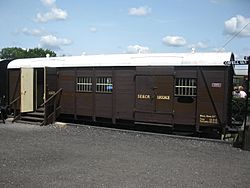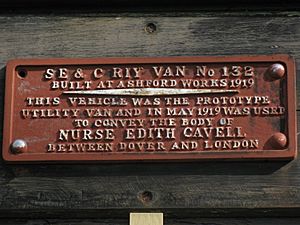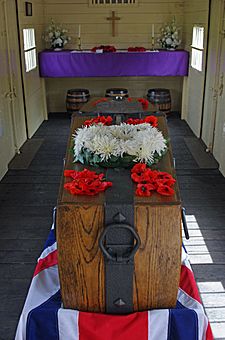Cavell Van facts for kids
The Cavell Van is a special train car built in 1919. It was the very first of its kind, designed to carry parcels and other items. This van is famous because it carried the bodies of three important British people back to the United Kingdom after the First World War. These were Edith Cavell, Charles Fryatt, and The Unknown Warrior. They were the only British people whose bodies were brought home after the war.
The Cavell Van was used by several railway companies, including the South Eastern and Chatham Railway, the Southern Railway, and British Railways. Today, it is preserved at the Kent and East Sussex Railway. It was fully restored in 2010, looking just like new!
Quick facts for kids Cavell Van |
|
|---|---|

The Cavell Van after restoration
|
|
| In service | 1919–91 |
| Manufacturer | South Eastern and Chatham Railway |
| Built at | Ashford Works |
| Family name | PMVY |
| Constructed | 1919 |
| Refurbishment | 2010 |
| Number built | 1 |
| Number preserved | 1 |
| Fleet numbers | 132 1972 DS734 082757 93 |
| Operator(s) | South Eastern and Chatham Railway Southern Railway British Railways (Southern Region) Kent and East Sussex Railway |
| Specifications | |
| Car length | 32 feet 0 inches (9.75 m) |
| Track gauge | 4ft 8½ in (1,435 mm) |
Contents
History of the Cavell Van
The Cavell Van was designed by Richard Maunsell. It was built in 1919 at Ashford Works by the South Eastern and Chatham Railway. It was the very first "Parcels and Miscellaneous Van" of its kind.
In 1919, this special van was used to carry the bodies of two people who had died during the First World War: Edith Cavell and Charles Fryatt. A year later, in 1920, it also carried the body of The Unknown Warrior.
Edith Cavell's Story
Edith Cavell was born in England in 1865. She became a nurse in 1907 and worked in hospitals in Belgium. During 1914–15, she bravely helped over 200 Allied POWs escape. She was arrested for this and later put to death.
Her body was brought back from Belgium in May 1919. The Cavell Van carried her body from Dover to London.
Charles Fryatt's Story
Charles Fryatt was born in England in 1872. He was a merchant mariner, which means he worked on ships that carried goods. He joined the Great Eastern Railway in 1892 and became a ship captain in 1913.
On March 28, 1915, his ship, the SS Brussels, was told to stop by a German submarine, U-33. But Captain Fryatt ordered his ship to go full speed ahead and tried to ram the submarine! The submarine quickly dived away.
Later, on June 25, 1916, Fryatt's ship was captured by the Germans. He faced a military trial and was put to death. His body was brought back in July 1919. The Cavell Van carried his body from Dover to London before his funeral at St. Paul's Cathedral.
The Unknown Warrior's Journey
The Unknown Warrior was a British soldier who died on a battlefield in Europe. His body was brought from Dover to London on the Cavell Van on November 10, 1920. The next day, November 11, 1920, his funeral service was held at Westminster Abbey.
The Van's Service History
The Cavell Van had several different numbers during its time in service. The South Eastern and Chatham Railway first called it 132. When it moved to the Southern Railway in 1923, it was renumbered 1972. Later, in 1946, it became 374S when it was used for railway department work. It was used as a storage van at different railway workshops.
Under British Railways, it was numbered DS734. In 1967, it was renumbered again to 082757. The van finished its working life at a cable depot in Guildford. It was taken out of service in 1991 and stored.
In 1992, the van was sold to the Tenterden Rolling Stock Group. It was then moved to the Kent and East Sussex Railway. It arrived at Wittersham Road on January 22, 1992. On the Kent and East Sussex Railway, it is known as number 93.
In 1994, the van was moved to the Rother Valley Railway. During its time there, it was sold again, and its condition got worse. It was sold one more time in 2003 and returned to the Kent and East Sussex Railway in 2004.
In December 2009, people started raising money to fully restore the van. They wanted to raise £35,000 and finish the restoration by November 10, 2010. This date was special because it was the 90th anniversary of the van carrying The Unknown Warrior's body.
The fully restored van was shown to the public on November 10, 2010. Now, it is used as a museum to remember The Unknown Warrior, Edith Cavell, and Charles Fryatt. The exhibition inside the van was created by students from Homewood School in Tenterden. They worked with the railway on this project. The students did research at the Imperial War Museum in London, where they even got to read letters written by Edith Cavell.
This project won a competition organized by the British Interactive Media Association on July 8, 2010. The Vintage Carriages Trust says the van is "very important" historically. In October 2015, the van was taken by road to Norwich, Norfolk. This was part of the events to remember the 100th anniversary of Edith Cavell's death. The van was on display outside The Forum until October 17.



